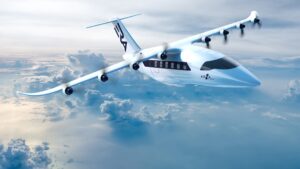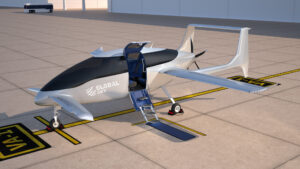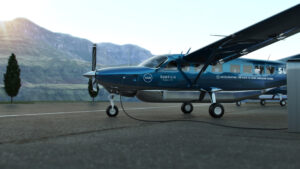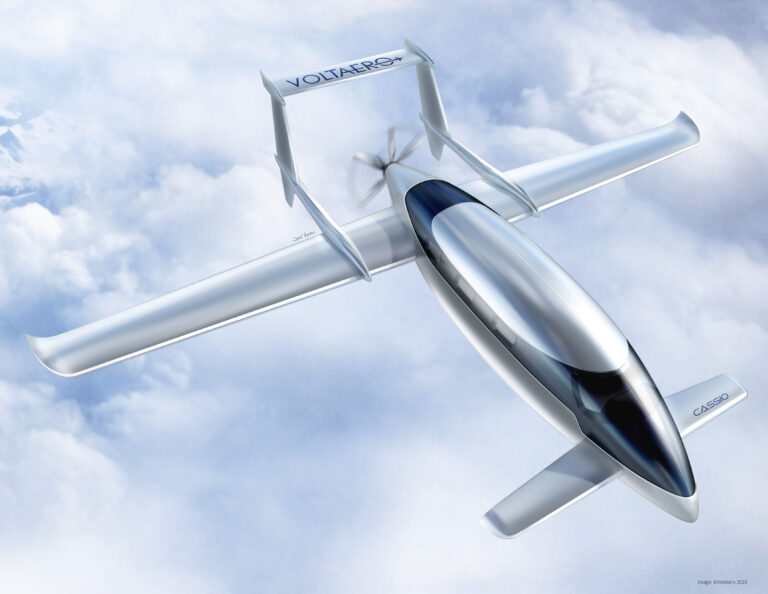Computer graphics of thousands of eVTOLs streaming through the air around futuristic skyscrapers have investors sinking billions worldwide on urban air mobility startups. But the next big change in aviation may could already be happening outside of cities, in the regional market. It will use aircraft that are familiar and share design charactristics and technology with small turboprop airplanes first developed 50 years ago.
Electric aircraft developers are restricted by current propulsion and battery technology to smaller aircraft. They are therefore targeting regional markets first, which can support such aircraft. Companies such as France’s Aura Aero and VoltAero, Sweden’s Heart Aerospace, Ampaire and Eviation in the USA are developing hybrid and all-electric aircraft that will carry between six and 25 passengers or several tonnes of cargo, with ranges that vary between a hundred up to 500 miles 160-800km).
Battery technology

Aura Aero’s engineers are using the same maturity gates (MG) method that Airbus uses for development and certification. “Early next year we will go through MG five, which marks the start of detailed design and ramps up industrialization readiness – preparing the manufacturing processes, the tooling, and preparing the supply chain,” says Drew McEwen, chief commercial officer, Aura Aero.
ERA is a Part 23 aircraft with a capacity for up to 19 passengers. McEwen admits ERA’s capacity and range are determined by current battery technology but believes that the smaller size of the aircraft is also an advantage in terms of certification, which will be under Part 23: “The certification requirements for Part 25, targeting bigger aircraft, are more complex. Part 23 is defined in a way that enables novel technologies such as hybrid-electric propulsion to be accounted for.
“Step-by-step technological development is an important part of our approach. In the next few weeks we will have a dedicated rig for testing in different configurations the hybridization laws we have designed through simulation. This technology is available today, we are just bringing it over to make hybrid electric possible.”
Business case
Operating costs are a major aspect of aircraft purchasing decisions. In regional aviation markets, cost has long been the determining factor in the viability of routes. Many new routes were created in the 1970s and 1980s in the USA and Europe that used turboprop aircraft. But these fell away as the size of aircraft increased and the economics changed in favor of narrowbody jets. Most regional operators could not compete with larger carriers on costs and were bought out.
Crucially, hybrid-electric and electric regional aircraft provide an opportunity to reduce operating costs, as well as emissions at the point of use. Aviation analysts believe this could lead to a rejuvenation of regional aviation markets over the next 10-15 years through a combination of fleet replacement – many regional aircraft are at the end of their lifetimes – and route expansion.
McEwen says, “The direct operating costs of ERA will be 30-50% less than a traditional turboprop regional aircraft thanks to fuel savings and a significant reduction in maintenance costs.
“This will mean people will be able to make money again – you will start seeing entrepreneurs get back into the business of regional airline service. You will see a lot more point-to-point and reemerging markets.
“Another key enabler here is the autonomous safety systems aircraft such as ERA will feature. This will enable the potential for single pilot operations beyond business / executive flights or cargo operations, improving safety and reducing costs.”
Another key difference this new breed of regional aircraft will offer compared to older turboprops is an improved passenger experience. Electric aircraft will be quieter and offer a smoother ride than older turboprop aircraft.
First to market
McEwen believes adoption will vary from country to country and depend on the different approaches governments take, but that Europe’s regional aviation markets seem to be moving quicker to electrify than the USA’s. Another key factor here will be the preparation of infrastructure, where close industry collaboration will be necessary.
“We are using current technology, 800 Volts, the same system that’s used in automotive. With ERA, it’s going to take you 30 minutes to charge,” says McEwen. “There are companies already designing solutions, such as booms with electric cords and the industry is beginning to adopt some common standards.”
Aura Aero has secured financial deposits and Letters of Intent from operators such as JSX and recently a Letter of Intent for up to 75 aircraft from freight operator Alpine Air, the largest operator of Beech 1900s in the USA.
“If we can provide the economics when these aircraft come to market it will be a no-brainer. Many smaller turboprop aircraft like this are at the end of their life. There is an existing market and strong demand,” says McEwen. “Plus, the aircraft’s range will only improve as battery technology develops – this will be the first time you buy an airplane and its performance and range increase over its lifetime.”
Proving grounds

As an operator, Luxembourg-based Sigma Air Mobility looks set to be amongst the first companies in the world to fly a hybrid-electric aircraft after it announced a partnership with France’s VoltAero at the Farnborough Air Show in July.
Sigma was founded in 2022 by the Luxaviation Group to help mature the Advanced Air Mobility market. Christophe Lapierre, CEO of Sigma believes that regional air mobility represents a significant market opportunity in the 300km (190 miles) -plus range. Furthermore, he says this part of the regional market has been under-addressed, and that hybrid electric conventional take-off and landing aircraft can more easily leverage existing infrastructure than eVTOLs.
Speaking at the Air Show in July, Lapierre said, “We are defining the networks and identifying the requirements. We want to validate the ecosystem and operations in this first project with a couple of aircraft. We have targeted 2026 for this. Then there are several markets in which we could be flying and we are checking the fleet size we will need.
“The agreement aligns our companies’ on a pragmatic and tangible path to market, validating Cassio operations and its infrastructure and ecosystem with a very local and streamlined pilot project.”
VoltAero is developing three aircraft that use a parallel electric-hybrid powertrain – the five-seat Cassio 330, the six-seat Cassio 480, and the Cassio 600 model for up to 12 passengers.
The first Cassio 330 aircraft should start flight testing early in 2025, with a second prototype flying by the end of the year. VoltAero is targeting 2026 to achieve type certification with EASA for the Cassio 330, with certification of the larger variants to follow.
The agreement between Sigma and VoltAero will see Sigma test VoltAero’s Cassio 330 operationally for business aviation use cases such as Medevac. Sigma plans to announce the routes for the trials before the end of 2024. The partnership will develop technical standards for airport recharging infrastructures and facilities. It will also look at operating models, economics and decarbonization trends and metrics to inform growth plans and fleet deployment.
“We want to open new routes and destinations up to local communities and provide new use cases and benefits to create value. When we have this compelling, economic integration, it will really be a game changer,” said Lapierre.
Heart Aerospace
Partnerships between regional operators and aircraft OEMs are established elsewhere in Europe. Sweden’s Heart Aerospace recently unveiled its first full-scale prototype hybrid-electric aircraft, the HX-1. Heart is working with several regional airlines, and recently announced a partnership with UK-based operator Loganair to explore potential use cases for its aircraft.
It also has a Letter of Intent from JSX for 50 ES-30s, investments from United Airlines and Air Canada and a use-case project partnership with Air New Zealand. These carriers and more, such as KLM, Lufthansa and Air Asia are also on an Industry Advisory Panel to “provide input on the design, development, and commercialization of the ES-30”.
The HX-1 is a predecessor to Heart’s ES-30, which will have a fully electric range of 200km (125 miles) and an extended hybrid range of 400km (250 miles). The aircraft will also have the capability to fly further with less passengers – up to 800km (500 miles) carrying 25 passengers.

Speaking at the HX-1 reveal event, Luke Farajallah, CEO of Loganair said, “I’m excited about the partnership. The size and specification of the aircraft that’s being developed, the technology that’s being used complement the way we look at the future generation of regional aircraft and regional airports. There is a good chance that hybrid technology could be the market leader in the coming years.”
Electric USA
Surf Air Mobility is taking a different approach to electrification of regional aviation. As well as operating a scheduled regional airline and an on-demand charter marketplace in the USA, it is developing its own electric aircraft with aerospace companies Magnix and AeroTEC. Effectively, it has in-housed the electrification of its regional aircraft fleet.
Surf Air’s goal is to modify the Cessna Grand Caravan Ex with a proprietary hybrid-electric powertrain.
The company has ordered up to 150 of the single-engine turboprop, which in its fossil-fuel configuration can carry up to 14 passengers or 3,195 lbs (1,449kg) of payload up to 1,240 miles (2,000km).
“We are focused on the Supplemental Type Certificate route to electrification,” says Jim Sullivan, president of Surf Air Mobility.
“Most companies developing electric aircraft are working on something completely new, sometimes with radical designs like vertical lift. We see modifying an existing airframe as being the shorter path to market.
“The change won’t happen overnight, but we are in a good position through our established airline to be one of the first companies to fully embrace the technology when it matures and take advantage of the growth.”
Sullivan agrees electrification’s greatest benefit will be operating cost savings, mainly in lower maintenance and fuel costs, but points out there are changes to be made on the ground. “We are going to need some level of infrastructure change from business partners and communities. Airports are very focused on aviation and when the need for different infrastructure arrives, so will the investment,” he says.
“Ultimately this is about lowering costs. The reason communities lose air service is that the airlines no longer have the economic capability to serve those communities. Many of the markets we fly are subsidized.”
Sullivan gives as an example the partnership Surf Air has with Purdue University, Indiana which ferries people between an airport near the campus and Chicago O’Hare Airport several times a day. “If we can do that kind of air service at lower cost and with green technology, we expect many more communities will take advantage,” he says.





